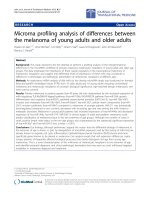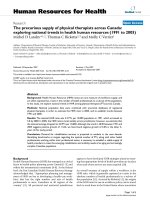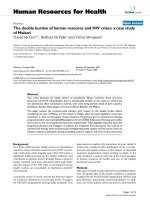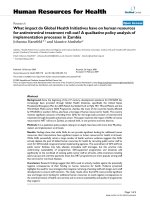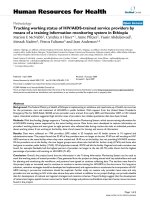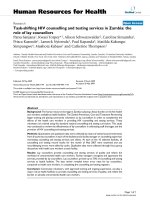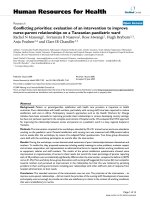Báo cáo sinh học: "Detailed genetic analysis of hemagglutinin-neuraminidase glycoprotein gene in human parainfluenza virus type 1 isolates from patients with acute respiratory infection between 2002 and 2009 in Yamagata prefecture, Japa" docx
Bạn đang xem bản rút gọn của tài liệu. Xem và tải ngay bản đầy đủ của tài liệu tại đây (243.79 KB, 19 trang )
Virology Journal
This Provisional PDF corresponds to the article as it appeared upon acceptance. Fully formatted
PDF and full text (HTML) versions will be made available soon.
Detailed genetic analysis of hemagglutinin-neuraminidase glycoprotein gene in
human parainfluenza virus type 1 isolates from patients with acute respiratory
infection between 2002 and 2009 in Yamagata prefecture, Japan
Virology Journal 2011, 8:533
doi:10.1186/1743-422X-8-533
Katsumi Mizuta ()
Mika Saitoh ()
Miho Kobayashi ()
Hiroyuki Tsukagoshi ()
Yoko Aoki ()
Tatsuya Ikeda ()
Chieko Abiko ()
Noriko Katsushima ()
Tsutomu Itagaki ()
Masahiro Noda ()
Kunihisa Kozawa ()
Tadayuki Ahiko ()
Hirokazu Kimura ()
ISSN
Article type
1743-422X
Research
Submission date
9 September 2011
Acceptance date
13 December 2011
Publication date
13 December 2011
Article URL
/>
This peer-reviewed article was published immediately upon acceptance. It can be downloaded,
printed and distributed freely for any purposes (see copyright notice below).
Articles in Virology Journal are listed in PubMed and archived at PubMed Central.
For information about publishing your research in Virology Journal or any BioMed Central journal, go
to
© 2011 Mizuta et al. ; licensee BioMed Central Ltd.
This is an open access article distributed under the terms of the Creative Commons Attribution License ( />which permits unrestricted use, distribution, and reproduction in any medium, provided the original work is properly cited.
Virology Journal
/>For information about other BioMed Central publications go to
/>
© 2011 Mizuta et al. ; licensee BioMed Central Ltd.
This is an open access article distributed under the terms of the Creative Commons Attribution License ( />which permits unrestricted use, distribution, and reproduction in any medium, provided the original work is properly cited.
Detailed genetic analysis of hemagglutininneuraminidase glycoprotein gene in human
parainfluenza virus type 1 isolates from patients
with acute respiratory infection between 2002
and 2009 in Yamagata prefecture, Japan
ArticleCategory
: Research Article
ArticleHistory
: Received: 09-Sep-2011; Accepted: 24-Nov-2011
© 2011 Mizuta et al; licensee BioMed Central Ltd. This is an Open Access
article distributed under the terms of the Creative Commons Attribution
ArticleCopyright : License ( which permits
unrestricted use, distribution, and reproduction in any medium, provided
the original work is properly cited.
Katsumi Mizuta,Aff1
Email:
Mika Saitoh,Aff2
Email:
Miho Kobayashi,Aff2
Email:
Hiroyuki Tsukagoshi,Aff2
Email:
Yoko Aoki,Aff1
Email:
Tatsuya Ikeda,Aff1
Email:
Chieko Abiko,Aff1
Email:
Noriko Katsushima,Aff3
Email:
Tsutomu Itagaki,Aff4
Email:
Masahiro Noda,Aff5
Email:
Kunihisa Kozawa,Aff2
Email:
Tadayuki Ahiko,Aff1
Email:
Hirokazu Kimura,Aff2 Aff6
Corresponding Affiliation: Aff6
Phone: +81-42-5610771
Fax: +81-42-5653315
Email:
Aff1
Yamagata Prefectural Institute of Public Health, 1-6-6 Toka-machi,
Yamagata-shi, Yamagata 990-0031, Japan
Aff2
Gunma Prefectural Institute of Public Health and Environmental
Sciences, 378 Kamioki-machi, Maebashi-shi, Gunma 371-0052, Japan
Aff3
Katsushima Pediatric Clinic, 4-4-12 Minamidate, Yamagata-shi,
Yamagata 990-2461, Japan
Aff4
Yamanobe Pediatric Clinic, 2908-14 Yamanobe-machi,
Higashimurayama-gun, Yamagata 990-0301, Japan
Aff5
Department of Virology III, National Institute of Infectious Diseases, 47-1 Gakuen, Musashimurayama-shi, Tokyo 208-0011, Japan
Aff6
Infectious Disease Surveillance Center, National Institute of Infectious
Diseases, 4-7-1 Gakuen, Musashimurayama-shi, Tokyo 208-0011, Japan
Abstract
Background
Human parainfluenza virus type 1 (HPIV1) causes various acute respiratory infections (ARI).
Hemagglutinin-neuraminidase (HN) glycoprotein of HPIV1 is a major antigen. However, the
molecular epidemiology and genetic characteristics of such ARI are not exactly known. Recent
studies suggested that a phylogenetic analysis tool, namely the maximum likelihood (ML)
method, may be applied to estimate the evolutionary time scale of various viruses. Thus, we
conducted detailed genetic analyses including homology analysis, phylogenetic analysis (using
both the neighbor joining (NJ) and ML methods), and analysis of the pairwise distances of HN
gene in HPIV1 isolated from patients with ARI in Yamagata prefecture, Japan.
Results
A few substitutions of nucleotides in the second binding site of HN gene were observed among
the present isolates. The strains were classified into two major clusters in the phylogenetic tree
by the NJ method. Another phylogenetic tree constructed by the ML method showed that the
strains diversified in the late 1980s. No positively selected sites were found in the present strains.
Moreover, the pairwise distance among the present isolates was relatively short.
Conclusions
The evolution of HN gene in the present HPIV1 isolates was relatively slow. The ML method
may be a useful phylogenetic method to estimate the evolutionary time scale of HPIV and other
viruses.
Keywords
Human parainfluenza virus, Maximum likelihood (ML) method, Phylogenetic analysis
Background
Human parainfluenza virus type 1 (HPIV1) of the genus Respirovirus and family
Paramyxoviridae causes various acute respiratory infections (ARI) including the common cold,
croup, bronchiolitis, and pneumonia [1]. Epidemiological data suggest that HPIV types 1–4
mainly infect younger children at least once, although reinfections may occur in adults [2,3].
Indeed, serological surveys indicate that at least 75% of children have been infected with HPIV1
by 5 years of age [4,5]. HPIV1 and 3 show high prevalence and are associated with up to 12% of
acute lower respiratory tract infections in adults [6]. Thus, HPIVs, including HPIV1, may be
major agents of ARI throughout the world [7-9].
HPIV possess two major surface glycoproteins: hemagglutinin-neuraminidase (HN) glycoprotein
and fusion protein (F protein) [1]. HN glycoprotein shows multiple biological functions that
include hemagglutinin and enzymatic activities as neuraminidase [3,10]. As a result, this
molecule regulates viral adsorption and entry, and regulates the release of progeny virions from
the infected cell surface [3]. In addition, it is suggested that HN glycoprotein is a major antigen
[1]. The detailed molecular characteristics of HN glycoprotein have been confirmed in HPIV3,
while those in HPIV1 remain unclear [11]. In addition, the genetic characteristics of HPIV1 are
poorly understood. Thus, it is important to analyze the HN coding region in HPIV1.
The neighbor joining (NJ) method is frequently used in phylogenetic analysis to examine the
molecular epidemiology of various viral genomes [12,13]. This method is based on a cluster
classification algorithm, enabling the analysis of clusters and of the rate of viral evolution.
Furthermore, the maximum likelihood (ML) method enables an estimation of the evolutionary
time scale [14]. Using these methods, we conducted a detailed genetic analysis of the HN coding
region in HPIV1 isolates from patients with ARI in Yamagata prefecture, Japan.
Methods
Patients and isolation of HPIV1
A total of 182 throat and nasal swab specimens were collected from patients attending pediatric
clinics in Yamagata prefecture from May 2002 to November 2009. Informed consent was
obtained from the parents of all subjects for the donation of samples used in this study. All
patients were aged from 0 to 43 years (4.1 ± 5.0 years; mean ± SD). Patients were mainly
diagnosed with upper respiratory illness (URI) and wheezy bronchiolitis (Additional file 1: Table
S1). URI is also known as the common cold and typically affects the upper airways, including
the nose (sinusitis), throat (pharyngitis), and larynx (laryngitis) [15]. Wheezy bronchiolitis was
defined as the presence of wheezing alone or chest retractions in association with URI [16].
Cell culture and virus isolation
In this study, human embryonic lung fibroblast (HEF), human laryngeal carcinoma (HEp-2),
African green monkey kidney (Vero E6), Madin Darby canine kidney (MDCK),
rhabdomyosarcoma (RD-18S), green monkey kidney (GMK), and human melanoma (HMV-II)
cell lines were grown in Roswell Park Memorial Institute medium (Nissui No.3; Nissui
Pharmaceutical Co., Ltd., Tokyo, Japan) containing 5–10% fetal bovine serum or calf serum at
37°C in a humidified atmosphere of 5% CO2 [17]. Each cell line was prepared in 96-well tissue
culture plates (Greiner Bio-One, GmbH, Frickenhausen, Germany). We inoculated the throat and
nasal swabs from patients onto the plates and incubated them at 33°C in a humidified atmosphere
of 5% CO2. The cytopathic effects (CPEs) in the cells were observed 2–3 times per week. We
harvested the culture supernatant when a suspected HPIV CPE was observed or a hemadsorption
(HAD) test with 0.8% guinea pig erythrocytes was positive, and stored it at −80°C until analysis.
RNA extraction, RT-PCR, and sequencing
Viral RNA of HPIV1 isolates was extracted from 200 µL of the viral culture fluid by using
ISOGEN (Nippon Gene, Tokyo, Japan) and was then transcribed into cDNA with M-MLV
reverse transcriptase (Nippon Gene) and a random primer (Takara Bio Inc., Otsu, Japan).
Reverse transcription was carried out at 30°C for 10 min, followed by incubation at 37°C for 45
min, and then incubation at 95°C for 5 min. To amplify the HN coding region in HPIV1 gene
(nucleotide position 7245–8477, 1233 nt) by RT-PCR, we designed new primer sets using
Primer Express (R) version 1.5 software (Applied Biosystems LLC, Foster City, CA) [18].
Primer sequences were as follows: first primer pair, 5′- CAG AAT TAA TCA GAC AAG AAG
TRA TAT CAA G -3′ (primer HPIV-1USF, position 7165–7195), and 5′- TGA TAC GRA TTA
AGA CAT TGA CAA CTT G -3′ (primer HPIV-1USR, position 8034–8061); and second primer
pair, 5′- CRA GTS RAG GWA TAG RAG AYT TAG TAT TTG -3′(primer HPIV-1DSF,
position 7750–7779) and 5′- GGT TRA TTT CAA CAA TRT GGA AGC AGT A -3′ (primer
HPIV-1DSR, position 8529–8556). Nucleotide position was based on the sequence of HN
glycoprotein genome in HPIV1 (Mil-48/91, GenBank accession no. U70936). Using cDNA
solution, a DNA fragment of 1392 bp was amplified by PCR. Forty amplification cycles were
performed at 94°C for 30 s, at 55°C for 30 s, at 72°C for 1 min, followed by a final extension at
72°C for 10 min. We analyzed the nucleotide sequences (1233b; located at 398–1633 within the
HN gene) of the HN coding region. Briefly, the DNA fragment was purified with a QIAquick
PCR Purification Kit (Qiagen, Valencia, CA), submitted to a cycle sequence with a Big Dye
Terminator v3.1 Cycle Sequencing Kit (Applied Biosystems, Warrington, UK) using the two
primer sets stated above, and purified with a spin column (AutoSeq G-50, Amersham
Biosciences, Piscataway, NJ). The nucleotide sequence was determined with an automated DNA
sequencer (ABI PRISM 3130 Genetic Analyzer, Applied Biosystems, Foster City, CA).
Phylogenetic analysis and calculation of pairwise distances by the NJ method
Phylogenetic analysis of the nucleotide sequence of the HN coding region of HPIV1 was
conducted with the CLUSTAL W program available from the DNA Data Bank of Japan
( and Tree Explorer version 2.12 [19].
Evolutionary distances were estimated according to Kimura’s 2-parameter method, and the
phylogenetic tree was constructed with the NJ method. The reliability of the tree was estimated
with 1000 bootstrap replications. We used reference strains in this study to construct the
phylogenetic tree. In addition, we calculated the pairwise distances for all strains, including the
present isolates and reference strains to assess the frequency distribution among all HPIV1
strains and that of each intercluster of HPIV1, as previously described [20]. The GenBank
accession numbers of the nucleotide sequences obtained in the present study are AB641132 to
AB641313.
To evaluate the action of selective pressure on the HN coding regions among all HPIV1 strains,
we estimated the rates of synonymous (dS) and non-synonymous (dN) changes at amino acid
sites by conservative single likelihood ancestor counting (SLAC) and the fixed effects likelihood
(FEL) method using ML available on the Datamonkey webserver ( />[21]. The SLAC method is suitable for fast likelihood-based “counting methods” that employ
either a single most likely ancestral reconstruction, weighted across all possible ancestral
reconstructions, or sampling from ancestral reconstructions. The FEL method directly estimates
dN and dS substitution rates at each site. These methods were performed to examine the dN and
dS rates, incorporating the General Time Reversible (GTR) model of nucleotide substitution and
the phylogenetic tree inferred using the NJ method. Positive (dN > dS) and negative (dN < dS)
selections were predicted using these models. The p-value was used to classify a site as
positively or negatively selected by these methods.
Phylogenetic analysis and estimation of time scale by the ML method
To construct the phylogenetic tree by the ML method, which is the best nucleotide substitution
model, the GTR with gamma distributed rates across sites (GTR + Γ) [22,23] was selected by the
KAKUSAN4 program version 4.0. Supplementary materials related to this program can be found
online at doi:10.1111/j.1755-0998.2011.03021.x. In this study, we used three phylogenetic
models of sequence evolution. One is the different rate (DR) model [14], the most general, which
assumes each branch of the unrooted phylogenetic tree has a different substitution rate [24]. The
DR model is used as suitable general model against which to test the assumption of constant
rates of the fit of the single rate (SR) and the single rate dated tips (SRDT) models [25].
Phylogenetic analysis of ML based on the DR model was constructed with RAxML BlackBox
webserver ( All the present strains with more
than 99.5% sequence similarity to any other strain were excluded from analysis. The reliability
of the phylogenetic hypothesis was assessed using bootstrap analysis of 100 ML iterations. The
SR model assumes the same rate of evolution in all branches (i.e., a molecular clock), and the
SRDT model is an SR model that relaxes the assumption of contemporaneous sequences and
uses the date of isolation of each sequence to estimate the substitution rate [24]. To estimate the
rate of molecular evolution (and hence a time scale) for a phylogeny consisting of date tips,
phylogenetic analyses by ML based on the SR and SRDT models were performed using the
TipDate webserver ( [24]. The
likelihood of the SR and SRDT models (with likelihood L0) were compared to that of the DR
model (with likelihood L1) in a likelihood ratio test (LRT) [14] of the fit of the model. The test
statistic is the difference in the log likelihood (∆) between the SR or SRDT model and the DR
model. In the LRT statistic, twice the ratio of log likelihoods (L1/L0) (2∆*) is expected to be χ2
distributed with degrees of freedom equal to their models. The DR model has 2n-3 free
parameters, the SR model has n-1, and the SRDT model has n-2 (a tree of n tips). In the LRT of
the fit of the SR and SRDT models compared with the DR, if the SR model is rejected in favor of
the DR model but the SRDT model is not, the SRDT model can be accepted as no worse a
description of the evolution date than the DR model. A P value of ≥0.05 was considered
statistically significant for the phylogenetic models. The resulting phylogenetic trees were
described using TreeExplorer version 2.12. The rates of nucleotide substitution, the date
estimating the root of the tree and the corresponding upper and lower 95% confidence intervals
(CIs) were calculated under the SRDT model using the TipDate webserver.
Results
Phylogenetic analysis of the nucleotide sequences of the HN coding region in
HPIV1 by the NJ method
The partial nucleotide sequences (1233 nt) of HN glycoprotein gene in a total of 182 isolates and
3 reference strains were analyzed. The phylogenetic tree based on the nucleotide sequences by
the NJ method is shown in Figure 1. The enlarged cluster shows the HPIV1 strains. The
phylogenetic tree containing the isolated and reference strains was classified into two unique
clusters with the exception of three Yamagata strains (HPIVi/Yamagata/2002/1433,
HPIVi/Yamagata/2002/1565, and HPIVi/Yamagata/2003/1122), clusters 1 and 2, and these
strains were classified into different clusters from the reference strains. The number of detected
strains in each cluster on the phylogenetic tree was as follows: cluster 1, 84 strains including
strains isolated during 2004–2009; and cluster 2, 95 strains from 2003 to 2005, and 2007 to
2009.
Figure 1 Phylogenetic tree of HN region by NJ method. Phylogenetic tree based on the
nucleotide sequence of the HN coding region (1233nt), including the present strains (182) and
representative reference strains (3). HPIV3 was used as an outgroup. Distance was calculated
according to Kimura’s 2-parameter method, and the tree was plotted with the neighbor-joining
method. Reference strains are shown in italic type. The larger tree was simply expanded for
HPIV1 strains, to clarify the distance of each of the minor clusters in the trees. The tree was
constructed by neighbor-joining analysis with labeling of the branches showing at least 70%
bootstrap support. The representation of the strain was changed from Yamagata/20XX/ZZZZ to
YXX/ZZZZ
Likelihood ratio test (LRT) of the fit of the models and timescale evolution of the
HN coding region in HPIV1 by the ML method
Based on the SRDT model [24,26], we constructed another phylogenetic tree consisting of dated
tips by using the nucleotide sequences of the HPIV1 HN coding region of 43 isolated strains
from patients in Yamagata prefecture and 3 reference strains by using the ML method. As a
result, the SR model was rejected as an adequate description of the evolution of the HPIV1 HN
coding region (p < 0.05). Therefore, the SRDT model was not significantly worse than the DR
model, indicating that this model adequately describes the substitution process (p = 0.06).
Through these processes, we obtained a phylogenetic tree by the ML method. The year of the
first major division in the present tree was estimated at 1950 (Figure 2; 95% CIs of 1935 to
1955). In addition, the ancestral strains of the present strains subdivided around 1987. Further
division occurred around 1989, resulting in the formation of two major clusters (clusters 1 and
2). Furthermore, we estimated the rate of molecular evolution from the tree as 7.68 × 10−4
substitutions per site per year (95% CIs of 4.80 × 10−4 to 1.07 × 10−3).
Figure 2 Phylogenetic tree of HN region by ML method. Phylogenetic tree based on the
nucleotide sequence of the HN coding region (1233 nt), including the present strains (43) and
representative reference strains (3), with branch lengths scaled under the SRDT model.
Reference strains are shown in italic type
Analysis of pairwise distances, substitutions of the second binding site, and
selective pressure of the HN coding region in HPIV1
The nucleotide and amino acid sequence identities among all 182 isolates were high at 92.6–
100% and 96.0–100%, respectively. In addition, we calculated the intercluster distances of
HPIV1 from the distribution of the pairwise distances. Based on the nucleotide sequences, the
pairwise distance was 0.018 ± 0.013 [mean ± SD, Figure 3a] for the 182 present and 3 reference
strains. The pairwise intercluster distances were as follows: cluster 1, 0.003 ± 0.002 (Figure 3b);
and cluster 2, 0.008 ± 0.005 (Figure 3c). Cluster 2 showed a large pairwise intercluster distance,
whereas that for cluster 1 was small. However, irregular peaks of pairwise distance are seen in
Figure 3, and we were not able to genotyping the present strains based on the pairwise distance
value. Next, amino acid substitutions in the analyzed HN coding region in the present strains
were found at 31sites (detailed substitution data not shown). Among these was an essential
substitution of the second binding site, N523S. This substitution (N523S) was seen in seven of
the present strains (HPIVi/Yamagata/2007/1577, HPIVi/Yamagata/2007/1599,
HPIVi/Yamagata/2007/2211, HPIVi/Yamagata/2007/2072, HPIVi/Yamagata/2007/2354,
HPIVi/Yamagata/2007/2274, and HPIVi/Yamagata/2008/413). These strains belonged in cluster
2 (Figure 1).
Figure 3 Distributions of pairwise distances for HPIV1 of HN region. (a) Distribution of
pairwise distances for the 182 present and 3 reference strains. (b) Distribution of pairwise
intercluster distances for cluster 1. (c) Distribution of pairwise intercluster distances for cluster 2
Selection pressure analysis was performed in the present strains, and the results showed a low
mean dN/dS ratio (0.17) (95% likelihood profile-based CIs, CI = 0.13–0.23) by the SLAC
method. Thus, the nucleotide substitutions predicted were largely synonymous. The dN/dS ratios
of the individual sites in the HN coding region were calculated by the SLAC and FEL methods
significant at the p < 0.1 level. However, neither method detected a positively selected site.
Discussion
In this study, we performed a detailed genetic analysis of HN glycoprotein gene in HPIV1
isolates from patients with ARI during 2002–2009 in Yamagata prefecture, Japan. The
phylogenetic tree constructed by the NJ method showed that the present HPIV1 isolates were
divisible into two major genetic clusters (Figure 1). The other tree constructed by the ML method
showed that the year of the first major division was estimated at 1950, and the ancestral strains
further subdivided at around 1987, resulting in three clusters (one minor and two major, Figure
2). The strains belonging to the two major clusters subdivided into many clusters after 2000. The
present HPIV1 isolates showed an overall high level of nucleotide sequence identity (92.6–
100%) of the HN coding region. Pairwise distance values based on the nucleotide sequences
among the present strains were relatively low (less than 0.06). In addition, there were no
positively selected sites found. These results suggest that several lineages of highly conserved
HN gene in HPIV1 were prevalent in Yamagata prefecture. The present strains could not be
provisionally type assigned from the pairwise distance values. Thus, the accumulation of large
amounts of data may be needed to genotype HPIV1 based on pairwise distance.
Homology and phylogenetic analysis by the NJ method is frequently used in molecular
epidemiological studies of various viruses. Homology analysis based on nucleotide sequences
mainly shows the similarities of the analyzed genes among the strains. Phylogenetic analysis by
the NJ method can give an estimation of the viral evolution rate and cluster classification.
Furthermore, the ML method can enable analysis of the time scale of the evolution of viral
genes. In the present study, we were able to estimate the viral evolution rate of HPIV1, cluster
classification, and the evolutionary time scale of the present isolates by applying the NJ and ML
methods to the detailed phylogenetic analysis of the HN coding region in HPIV1. There is
currently little information available regarding the molecular evolution of the HN coding region
in HPIV (HPIV1 to 4). Furthermore, the rate of molecular evolution is very low (7.68 × 10−4
substitutions/site/year) in the present strains. Previous reports suggest that the rate of another
gene of respiratory viruses belonging to Paramyxoviridae, such as respiratory syncytial (RS)
virus, is higher (1.8 × 10−3 substitutions/site/year) than that of the present data [27]. The reason
for the difference is unknown at present. However, it is possible that genome properties other
than size, such as polarity or structure, may be associated with substitutions of the viral genome
[27]. Further studies on the detailed mechanisms of viral genome substitution may be needed.
Additional sequence data and further structural analysis are required to demonstrate the
mechanisms of the molecular evolution of HPIV1.
HPIV is classified into four serotypes (HPIV1 to 4), all of which can cause various ARI in
humans, such as URI, croup, bronchitis, and pneumonia [1]. Previous reports suggest that HPIV1
and 3 are the dominant viruses in children with ARI [28]. In addition, HPIV is a major causative
agent of virus-induced asthma [29]. Thus, HPIV1 is a major agent of ARI, along with other
viruses, such as adenovirus, RS virus, human metapneumovirus, and rhinovirus [30]. However,
the molecular epidemiology of HPIVs is poorly understood, and only a few reports on the
molecular epidemiology of HPIV1 are available. For example, Henrickson and Savatski
analyzed the longitudinal evolution of the HN coding region in 13 strains of HPIV1 isolated in
the United States [31]. The results showed that the antigenic and genetic subgroups are very
stable. Another report suggested that two distinct genotypes of HPIV were detected during the
1991 Milwaukee epidemic [32]. In the present study, we used HPIV1 isolates from patients with
ARI and studied the evolution of HN protein, based on phylogenetic analyses using both the ML
and NJ methods and the rate of the substitutions of nucleotides. The results showed that HN
protein is highly conserved. In addition, no positively selected sites were detected. To our best
knowledge, this is the first report of these findings in HPIV1.
The distribution of amino acids affects the structure of the HN coding region in HPIV1, and
previous reports show that substitutions of amino acids in HN glycoprotein reveal second
receptor binding sites [33,34]. For example, substitutions at Asn173 and Asn523 are critical for
the formation of a second binding site. In particular, these substitutions affect, for example, the
inhibitor in hemagglutination inhibition (HI) assays and infection of culture cells. However, the
second receptor binding site did not significantly affect the growth or fusion activity of HPIV1.
Substitutions at N523S were found in seven of the present strains, but there were no substitutions
at Asn173. Thus, we thought that N523S may not be significantly associated with infectivity or
pathogenicity.
Furthermore, we then examined selective pressure by counting and the ML method. Analysis of
selection pressure in the present strains showed that dS substitutions predominated over dN
substitutions, and no positively selected sites (substitution) were found in HN protein in the
present HPIV1 strains. The evolution of the present strains may be largely driven by purifying
selection. Compared with HPIV3, little is known about the detailed biological properties of HN
glycoprotein in HPIV1. As an essential molecule of these viruses, further analysis of the
biological properties of HN glycoprotein in HPIV1 is required [35].
Although detailed data of the antigenic and catalytic sites of HN molecules in HPIV3 is
relatively clear [36], such information regarding HPIV1 is not yet known. Moreover, the
epidemiology and molecular epidemiology of HPIV is not exactly known. Thus, further and
larger epidemiological/molecular epidemiological studies are required to give better
understanding of the etiology of HPIVs, including HPIV1.
Conclusions
Our study suggested that several prevalent lineages of HN gene are highly conserved and
evolution occurred from the late 1980s in HPIV1 in Yamagata prefecture. Viral evolution was
estimated by detailed phylogenetic analyses using the NJ and ML methods. These methods offer
a new understanding of the genetic evolution of HN gene.
Abbreviations
HPIV1: Human parainfluenza virus type 1, ARI: Acute respiratory infections, HN:
Hemagglutinin-neuraminidase, NJ: Neighbor joining, ML: Maximum likelihood, URI: Upper
respiratory illness, CPE: Cytopathic effect, HAD: Hemadsorption, dS: Synonymous, dN: Nonsynonymous, SLAC: Single likelihood ancestor counting, FEL: Fixed effects likelihood, GTR:
General time reversible, DR: Different rate, SR: Single rate, SRDT: Single rate dated tips, LRT:
Likelihood ratio test, CI: Confidence interval, RS: Respiratory syncytial, HI: Hemagglutination
inhibition
Competing interests
The authors declare that they have no competing interests.
Authors’ contributions
KM and HK designed the research project; MS, MK, HT, YA, TI, CA, and NK performed the
research; TI, MN, KK, and TA contributed the analytical tools; KM, MS, MK, and HK analyzed
the data, and KM, MS, and HK wrote the paper. All authors read and approved the final
manuscript.
Acknowledgements
This work was partly supported by a Grant-in-Aid from the Japan Society for the Promotion of
Science and for Research on Emerging and Re-emerging Infectious Diseases from the Ministry
of Health, Labour and Welfare, Japan.
References
1. Karron RA, Collins PL: Parainfluenza viruses. In Fields virology. volume 1. 5th edition.
Edited by Knipe DM, Howley PM. Philadelphia: Lippincott Williams & Wilkins; 2007:1497–
1526.
2. Griffin MR, Walker FJ, Iwane MK, Weinberg GA, Staat MA, Erdman DD, New Vaccine
Surveillance Network Study Group: Epidemiology of respiratory infections in young
children: insights from the new vaccine surveillance network. Pediatr Infect Dis J 2004, 23
(11 Suppl.):S188–192.
3. Moscona A: Entry of parainfluenza virus into cells as a target for interrupting childhood
respiratory disease. J Clin Invest 2005, 115:1688–1698.
4. Parrott RH, Vargosko A, Luckey A, Kim HW, Cumming C, Chanock R: Clinical features of
infection with hemadsorption viruses. N Engl J Med 1959, 260:731–738.
5. Parrott RH, Vargosko AJ, Kim HW, Bell JA, Chanock RM: Acute respiratory diseases of
viral etiology. III. parainfluenza. Myxoviruses. Am J Public Health Nations Health 1962,
52:907–917.
6. Matsuse H, Kondo Y, Saeki S, Nakata H, Fukushima C, Mizuta Y, Kohno S: Naturally
occurring parainfluenza virus 3 infection in adults induces mild exacerbation of asthma
associated with increased sputum concentrations of cysteinyl leukotrienes. Int Arch Allergy
Immunol 2005, 138:267–272.
7. Do AH, van Doorn HR, Nghiem MN, Bryant JE, Hoang TH, Do QH, Van TL, Tran TT, Wills
B, Nguyen VC, Vo MH, Vo CK, Nguyen MD, Farrar J, Tran TH, de Jong MD: Viral etiologies
of acute respiratory infections among hospitalized Vietnamese children in Ho Chi Minh
City, 2004–2008. PLoS One 2011, 6:e18176.
8. Iwane MK, Edwards KM, Szilagyi PG, Walker FJ, Griffin MR, Weinberg GA, Coulen C,
Poehling KA, Shone LP, Balter S, Hall CB, Erdman DD, Wooten K, Schwartz B, New Vaccine
Surveillance Network: Population-based surveillance for hospitalizations associated with
respiratory syncytial virus, influenza virus, and parainfluenza viruses among young
children. Pediatrics 2004, 113:1758–1764.
9. Laurichesse H, Dedman D, Watson JM, Zambon MC: Epidemiological features of
parainfluenza virus infections: laboratory surveillance in England and Wales, 1975–1997.
Eur J Epidemiol 1999, 15:475–484.
10. Henrickson KJ: Parainfluenza viruses. Clin Microbiol Rev 2003, 16:242–264.
11. Lawrence MC, Borg NA, Streltsov VA, Pilling PA, Epa VC, Varghese JN, McKimmBreschkin JL, Colman PM: Structure of the haemagglutinin-neuraminidase from human
parainfluenza virus type III. J Mol Biol. 2004, 335:1343–1357.
12. Kimura M: A simple method for estimating evolutionary rates of base substitutions
through comparative studies of nucleotide sequences. J Mol Evol 1980, 16:111–120.
13. Saitou N, Nei M: The neighbor-joining method: a new method for reconstructing
phylogenetic trees. Mol Biol Evol 1987, 4:406–425.
14. Felsenstein J: Evolutionary trees from DNA sequences: a maximum likelihood
approach. J Mol Evol 1981, 17:368–376.
15. Cherry JD: The Common Cold. In Textbook of Pediatric Infectious Diseases. 5th edition.
Edited by Feigin RD, Cherry JD, Demmler GJ, Kaplan SL. Philadelphia: Saunders; 2003:140–
146.
16. Robert CW: Bronchiolitis and Infectious Asthma. In Textbook of Pediatric Infectious
Diseases. 5th edition. Edited by Feigin RD, Cherry JD, Demmler GJ, Kaplan SL. Philadelphia:
Saunders; 2003:273–282.
17. Mizuta K, Abiko C, Aoki Y, Suto A, Hoshina H, Itagaki T, Katsushima N, Matsuzaki Y,
Hongo S, Noda M, Kimura H, Ootani K: Analysis of monthly isolation of respiratory viruses
from children by cell culture using a microplate method: a two-year study from 2004 to
2005 in Yamagata, Japan. Jpn J Infect Dis 2008, 61:196–201.
18. Itagaki T, Abiko C, Ikeda T, Aoki Y, Seto J, Mizuta K, Ahiko T, Tsukagoshi H, Nagano M,
Noda M, Mizutani T, Kimura H: Sequence and phylogenetic analyses of Saffold cardiovirus
from children with exudative tonsillitis in Yamagata, Japan. Scand J Infect Dis 2010,
42:950–952.
19. Kumar S, Tamura K, Nei M: MEGA3: Integrated software for Molecular Evolutionary
Genetics Analysis and sequence alignment. Brief Bioinform 2004, 5:150–163.
20. Mizuta K, Hirata A, Suto A, Aoki Y, Ahiko T, Itagaki T, Tsukagoshi H, Morita Y, Obuchi
M, Akiyama M, Okabe N, Noda M, Tashiro M, Kimura H: Phylogenetic and cluster analysis of
human rhinovirus species A (HRV-A) isolated from children with acute respiratory
infections in Yamagata, Japan. Virus Res 2010, 147:265–274.
21. Pond SL, Frost SD: Datamonkey: Rapid detection of selective pressure on individual
sites of codon alignments. Bioinf 2005, 21(10):2531–2533.
22. Yang Z: Estimating the pattern of nucleotide substitution. J Mol Evol 1994, 39:105–111.
23. Yang Z: Maximum likelihood phylogenetic estimation from DNA sequences with
variable rates over sites: approximate methods. J Mol Evol 1994, 39:306–314.
24. Rambaut A: Estimating the rate of molecular evolution: incorporating noncontemporaneous sequences into maximum likelihood phylogenies. Bioinf 2000, 16:395–
399.
25. Goldman N: Statistical tests of models of DNA substitution. J Mol Evol 1993, 36:182–198.
26. Renner SS: Relaxed molecular clocks for dating historical plant dispersal events. Trends
Plant Sci 2005, 10:550–558.
27. Sanjuán R, Nebot MR, Chirico N, Mansky LM, Belshaw R: Viral mutation rates. J Virol
2010, 84(19):9733–9748.
28. Reed G, Jewett PH, Thompson J, Tollefson S, Wright PF: Epidemiology and clinical
impact of parainfluenza virus infections in otherwise healthy infants and young children<5
years old. J Infect Dis 1997, 175:807–813.
29. Hashimoto S, Matsumoto K, Gon Y, Ichiwata T, Takahashi N, Kobayashi T: Viral infection
in asthma. Allergol Int 2008, 57:21–31.
30. Monto AS: Occurrence of respiratory virus: time, place and person. Pediatr Infect Dis J
2004, 23 (1 Suppl):S58–64.
31. Henrickson KJ, Savatski LL: Antigenic structure, function, and evolution of the
hemagglutinin-neuraminidase protein of human parainfluenza virus type 1. J Infect Dis
1997, 176:867–875.
32. Henrickson KJ, Savatski LL: Two distinct human parainfluenza virus type 1 genotypes
detected during the 1991 Milwaukee epidemic. J Clin Microbiol 1996, 34:695–700.
33. Alymova IV, Taylor G, Mishin VP, Watanabe M, Murti KG, Boyd K, Chand P, Babu YS,
Portner A: Loss of the N-linked glycan at residue 173 of human parainfluenza virus type 1
hemagglutinin-neuraminidase exposes a second receptor-binding site. J Virol 2008,
82:8400–8410.
34. Bousse T, Takimoto T: Mutation at residue 523 creates a second receptor binding site on
human parainfluenza virus type 1 hemagglutinin-neuraminidase protein. J Virol 2006,
80:9009–9016.
35. Porotto M, Greengard O, Poltoratskaia N, Horga MA, Moscona A: Human parainfluenza
virus type 3 HN-receptor interaction: effect of 4-guanidino-Neu5Ac2en on a
neuraminidase-deficient variant. J Virol 2001, 75:7481–7488.
36. Porotto M, Fornabaio M, Kellogg GE, Moscona A: A second receptor binding site on
human parainfluenza virus type 3 hemagglutinin-neuraminidase contributes to activation
of the fusion mechanism. J Virol 2007, 81:3216–3228.
Additional files
Additional_file_1 as DOC
Additional file 1. Table S1. Subject data in this study.
Top
Y04/1907
77 Y04/1071
Y04/1907
Y04/1071
Y04/1379
Y05/1504
81 Y05/1029, Y05/1059, Y05/1094
Y05/1033, and others (23)
Y05/2107
Y06/379
Y06/161, Y06/451
Y06/55
Y05/1849, Y05/2702
Y05/2637
96 Y07/1437, Y07/1477
Y07/1412
Y05/1356
Y05/1357
Y06/890, Y06/1093
Y08/2017
72 Y09/2272
Y09/2573
Y09/2352
80 Y09/2531
Y07/1645
Y05/1774
86 Y05/2105
Y08/1154
Y07/2125
Y08/1663
Y05/1932
Y06/360
Y06/1484
Y05/2227
Y07/400, Y07/1759
Y05/2624
Y07/2187, Y07/2227
Y07/1916
Y05/2570
Y05/862,and others (4)
Y06/305
Y05/1501, and others (4)
Y07/1662
Y06/1116
Y07/1562
Y06/3027
Y05/1388
Y07/1577, Y07/1599, Y07/2211
Y07/2354
94
Y08/413
Y07/2072
Y07/2274
Y09/2225, and others (4)
Y09/2019
Y09/1292, and others (10)
74
Y09/1653
Y09/1251
Y09/1542
Y09/1442
Y09/1660, Y09/1686
Y09/1786
74 Y09/1441
Y09/1412, and others (8)
Y09/2055
76 Y09/1346
Y09/1681
94
89 Y09/2009, and others (3)
Y09/2075
Y09/2143
Y09/1972
95
Y08/2018
Y07/1657, Y08/2276
Y07/1907
Y09/2581
Y04/1279
97 Y08/982
98 Y03/1644
Y03/1764
Y03/1368
Y03/1521
Y03/1523
Y03/2101
Y04/1773
Y04/759
Y03/1323, Y03/2066, Y03/1665
Y03/1446
Y03/2030
Y05/1109, and others (21)
Y05/1789
84
Y05/1346
97
Y02/1433,Y02/1565
Y03/1122
70
Mil-48/91 (U70936)
Washington/1964 (AF457102)
93
Mil-58/91 (U70943)
77
Simply expanded
86
HPIV1
87
100
86
TEX/9305/82 (M18763)
HPIV3 (M20402)
KK24 (AB189960)
ZHYMgz01 (EU326526)
HPIV3
0.05
74
70
93
0.005
Figure 1
Y04/1379
Y05/1504
Y05/1029, Y05/1059, Y05/1094
Y05/1033, and others (23)
Y05/2107
Y06/379
Y06/161, Y06/451
Y06/55
Y05/1849, Y05/2702
Y05/2637
96 Y07/1437, Y07/1477
Y07/1412
Y05/1356
Y05/1357
Y06/890, Y06/1093
Y08/2017
72
Y09/2272
Y09/2573
Y09/2352
80 Y09/2531
Y07/1645
Cluster 1
Y05/1774
Y05/2105
Y08/1154
Y07/2125
Y08/1663
Y05/1932
Y06/360
Y06/1484
Y05/2227
Y07/400, Y07/1759
Y05/2624
Y07/2187, Y07/2227
Y07/1916
Y05/2570
Y05/862,and others (4)
Y06/305
Y05/1501, and others (4)
Y07/1662
Y06/1116
Y07/1562
Y06/3027
Y05/1388
Y07/1577, Y07/1599, Y07/2211
Y07/2354
94
Y08/413
Y07/2072
Y07/2274
Y09/2225, and others (4)
Y09/2019
Y09/1292, and others (10)
Y09/1653
Y09/1251
Y09/1542
Y09/1442
Y09/1660, Y09/1686
Y09/1786
74 Y09/1441
Y09/1412, and others (8)
Y09/2055
Y09/1346
76
Y09/1681
94
89 Y09/2009, and others (3)
Y09/2075
Y09/2143
Y09/1972
95
Y08/2018
Y07/1657, Y08/2276
Y07/1907
Y09/2581
Y04/1279
97 Y08/982
Y03/1644
98
Y03/1764
Y03/1368
Y03/1521
Y03/1523
Y03/2101
Y04/1773
Y04/759
Y03/1323, Y03/2066, Y03/1665
Y03/1446
Y03/2030
Y05/1109, and others (21)
Y05/1789
84
Y05/1346
97
Y02/1433,Y02/1565
Y03/1122
Mil-48/91 (U70936)
Washington/1964 (AF457102)
Mil-58/91 (U70943)
81
Cluster 2
Top
Branch length
0
0.01
0.02
0.04
0.03
0.05
Mil-48/91(U70936)
HPIVi/Yamagata/2002/1433
HPIVi/Yamagata/2003/1122
HPIVi/Yamagata/2004/1071
HPIVi/Yamagata/2004/1907
HPIVi/Yamagata/2006/161
HPIVi/Yamagata/2005/1033
HPIVi/Yamagata/2006/55
HPIVi/Yamagata/2007/400
HPIVi/Yamagata/2007/1645
HPIVi/Yamagata/2007/1662
Cluster 1
HPIVi/Yamagata/2007/1437
HPIVi/Yamagata/2005/1357
HPIVi/Yamagata/2009/2272
HPIVi/Yamagata/2009/2352
HPIVi/Yamagata/2009/2531
HPIVi/Yamagata/2008/2017
HPIVi/Yamagata/2005/2227
HPIVi/Yamagata/2005/862
HPIVi/Yamagata/2008/1663
HPIVi/Yamagata/2005/1029
HPIVi/Yamagata/2005/1388
HPIVi/Yamagata/2003/1644
HPIVi/Yamagata/2003/1521
HPIVi/Yamagata/2005/1109
HPIVi/Yamagata/2005/1789
HPIVi/Yamagata/2004/1279
HPIVi/Yamagata/2007/2274
HPIVi/Yamagata/2007/2072
HPIVi/Yamagata/2007/1577
HPIVi/Yamagata/2007/1657
HPIVi/Yamagata/2009/2581
HPIVi/Yamagata/2009/2009
HPIVi/Yamagata/2009/2075
HPIVi/Yamagata/2009/2055
HPIVi/Yamagata/2009/1251
HPIVi/Yamagata/2009/1441
HPIVi/Yamagata/2009/1786
HPIVi/Yamagata/2009/2019
HPIVi/Yamagata/2009/1653
HPIVi/Yamagata/2003/1323
HPIVi/Yamagata/2003/2030
HPIVi/Yamagata/2004/1773
HPIVi/Yamagata/2003/2101
Washington/1964 (AF457102)
Mil-58/91(U70943)
1950
Figure 2
1960
1970
1980
1990
Year
2000
2010
Cluster 2
Top
(b) Cluster 1
Pairwise distance 0.003±0.002 (mean±SD)
(a) All HPIV1 strains
Pairwise distance 0.018±0.013 (mean±SD)
1000
1500
Number
Number
1000
500
500
0
0
0
0.01
0.02
0.03
0.04
0.05
0.06
Pairwise distance
(c) Cluster 2
Pairwise distance 0.008±0.005 (mean±SD)
Number
1500
1000
500
0
0
0.01
Pairwise distance
Figure 3
0.02
0
0.01
Pairwise distance
Additional files provided with this submission:
Additional file 1: supp1.doc, 32K
/>


